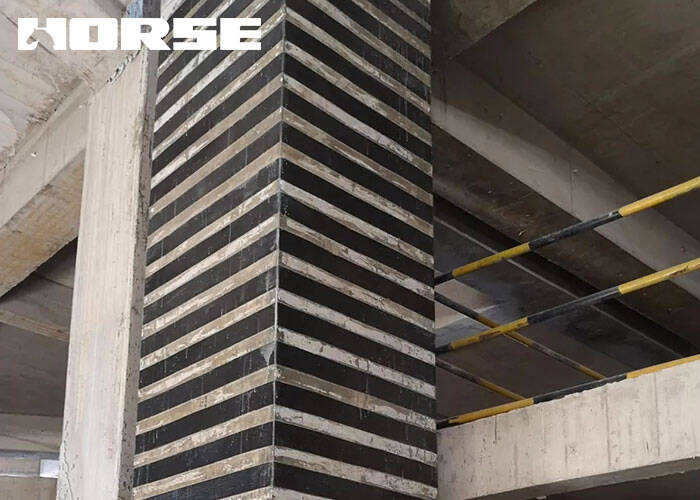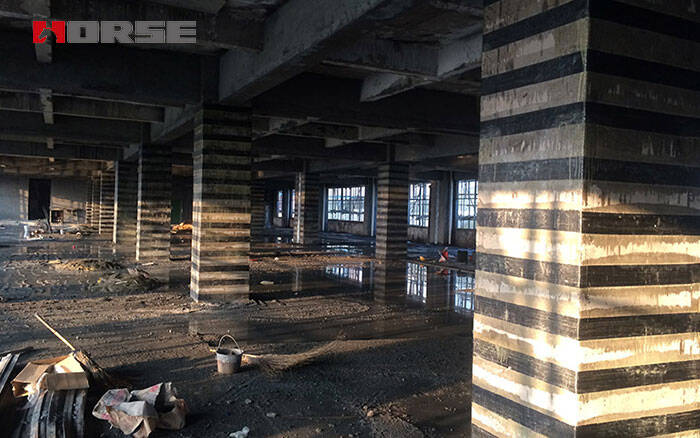Solutions
Horse Construction offers full range of structural strengthening materials with technical supports, documentation supports, products supports, project supports.
Carbon Fiber CFRP Strengthening Concrete Column

CFRP strengthening principle of reinforced concrete column
When reinforced concrete columns are subjected to axial pressure, the members are caused by lateral expansion with a very small limit value. For example, a lateral constraint can be created around the member to prevent this lateral expansion of the compressed member, thereby improving the compressive bearing capacity and deformability of the member. Carbon fiber CFRP-strengthened reinforced concrete column is to produce restraint between column concrete and CFRP reinforced belt, and the interaction between them is called interface restraint stress. Affected by the constrained stress of the transverse interface, the core concrete in the plastic zone is in a three-dimensional stress state. Compared with the unidirectional stress state, the ultimate compressive strain and bearing capacity of concrete will increase. In the case that the bending bearing capacity of the column does not decrease significantly, the effect of instability is not considered, and the reinforced concrete column has a larger ductile deformation and energy dissipation capacity after reinforcement.
Stress distribution of reinforced concrete column under CFRP wrap
1) Due to the lateral restraint of CFRP on the reinforced concrete column, CFRP forms an axial tensile stress, and the bending resistance of CFRP is extremely weak (generally not considered). The ultimate ultimate axial compressive strength of the rectangular column under the CFRP wrapping constraint is greatly reduced compared to that of the column, mainly due to the uneven lateral restraint stress. The central lateral restraint of the rectangular column side is weak, and the lateral stress concentration restraint at the corner is relatively large. Only when the side plastic deformation occurs, the lateral restraint stress of CFRP on the reinforced concrete column can increase rapidly.
2) Since the restraint of CFRP on the reinforced concrete column is the interface restraint, only when the concrete expands laterally, CFRP can produce restraining stress on the concrete. Therefore, the column ring-wrapped CFRP exhibits a two-stage force process when under load. In the first stage, the axial compressive stress of the concrete column is small, the lateral deformation is small, and the CFRP stress is small. In the second stage, as the load increases, the deformation of the column concrete column increases, the CFRP hoop stress increases significantly, and the hoop restraint force increases rapidly, until CFRP breaks when it reaches its ultimate tensile strain. The increase in the restraint stress and strain value of CFRP on concrete is related to the specification, paste form, and number of layers of CFRP material used, and should be determined through experiments.

CFRP reinforcement technology and construction key points of reinforced concrete columns
1) CFRP applicable scope and working condition requirements
CFRP-reinforced reinforced concrete columns are suitable for cylindrical or small cross-section rectangular columns (the side length of the section is generally less than 8oOrI1n1), which can greatly improve the axial bearing capacity of the reinforced concrete column when it is not unstable. The prerequisite for reinforcement is that the core concrete of the component has not been destroyed and still has a certain bearing and deformation capacity.
2) Reinforced concrete column outsourcing CFRP strengthening technology
2.1) Preliminary preparation
In actual projects, the columns that need to be reinforced always work under different working conditions. Before reinforced concrete columns are reinforced, a certain amount of unloading work is required for the components. Clean up the surface of the component, remove the surface concrete floating slurry and loose concrete, and repair the surface defects or unevenness of the component with one-level concrete or high-grade mortar. The rectangular column must be chamfered to relieve the concentrated stress at the corners, and the chamfering radius shall not be less than 20mm.
2.2) Paste on the upper surface of the concrete
According to concrete reinforcement requirements and test conditions, single-layer or multi-layer hoop interval reinforcement or full-section outsourcing reinforcement can be used. CFRP adhesives are all organic adhesives (specially designed epoxy resin II), and inorganic adhesives are still in the development stage. The quality of component reinforcement has a direct impact on the adhesive glue. According to the investigation of the authoritative department, the adhesive glue on the market is not optimistic. Therefore, the quality of the adhesive glue must be tested before construction and can be used only if it is qualified.
CFRP pasting procedure: brush the bottom layer of glue, paste the first layer of CFRP fiber cloth, and epoxy resin impregnated CFRP fiber cloth. If you use multilayer CFRP paste, repeat the above process.
3) CFRP reinforcement construction points
3.1) Unloading before reinforcement of reinforced concrete columns is often overlooked. When a concrete component is wrapped with CFRP under load, there is a strain lag between the wrapped CFRP and the surface of the concrete column, and it often happens that the CFRP has not been broken and the concrete column has been crushed. Therefore, the outsourcing of CFRP on concrete members under load reduces the reinforcement effect of CFRP and cannot fully exert the high-strength tensile properties of CFRP.
3.2) The radius of the corner chamfering of the rectangular column shall not be less than 20mm. The column side is best to be made into a convex surface to reduce the concentrated stress of CFRP at the corner. Many tests have shown that even so, the damage of CFRP still occurs at the corner.
3.3) The repair of the surface of concrete members is extremely important, which directly affects the effect of CFRP on the lateral restraint of concrete.
In conclusion
1) Carbon fiber CFRP reinforced reinforced concrete columns can change the concrete column from an axially stressed state to a three-way stressed state, constrain the lateral deformation of the concrete column, thereby increasing the axial bearing capacity of the concrete column. Especially for reinforced concrete columns whose axial compression ratio cannot meet the requirements of seismic design codes, the effect is obvious.
2) Improve the bearing capacity and ductility of the plastic hinge area. Under the repeated action of seismic loads, the upper and lower ends of the reinforced concrete column will first appear in the plastic hinge area, and the bearing capacity and ductility will decline rapidly. After winding and strengthening with CFRP, the deformation of the core concrete in the plastic hinge zone is greatly improved.
3) The construction technology is good, the process is simple, the restraint effect is good, and the corrosion resistance is strong. It only needs protection and does not need maintenance.
4) Carbon fiber CFRP reinforcement technology is not a universal "prescription", and it has some shortcomings. The organic glue has poor high temperature resistance, and cannot be used in buildings with high requirements for high temperature environments and fire protection; irregular or large cross-section rectangular columns should be used conditionally.
You can find anything here you are in need of, have a trust trying on these products, you will find the big difference after that.

High strength, unidirectional carbon fiber wrap pre-saturated to form a carbon fiber reinforced polymer (CFRP) wrap used to strengthen structural concrete elements.

High strength, unidirectional carbon fiber fabric pre-saturated to form a carbon fiber reinforced polymer (CFRP) fabric used to strengthen structural concrete elements.

High strength, unidirectional carbon fiber sheet pre-saturated to form a carbon fiber reinforced polymer (CFRP) sheet used to strengthen structural concrete elements.